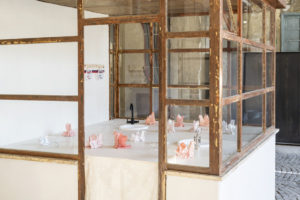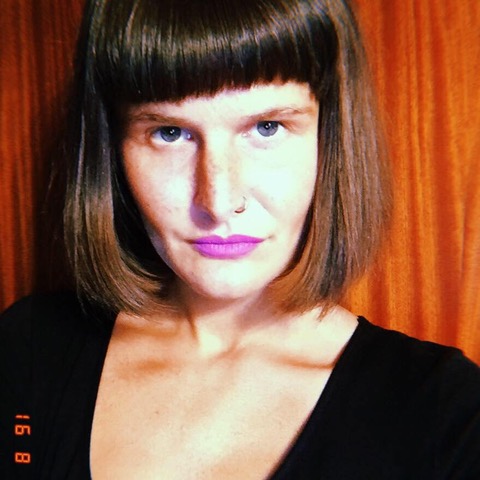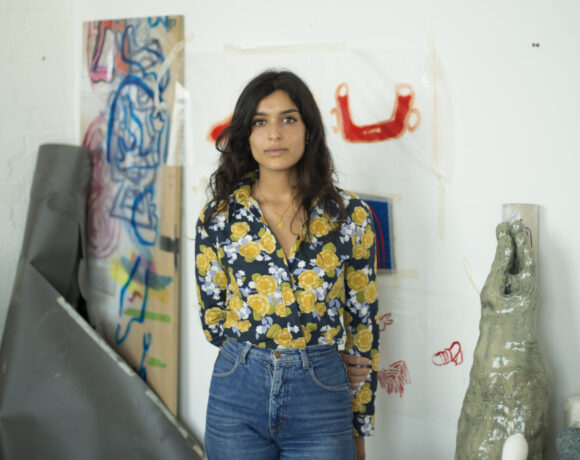We interviewed Guendalina Cerruti (1992) a young Italian artist based in London. After graduating in Visual Arts at NABA in Milan, she earned a Masters in Sculpture at the Royal College of Art in London. In her work she builds installations, compositions of objects, sculptures and images. The things that inhabit her practice and her imagery refer to the concept of domestic and familiar. She was recently the protagonist of the exhibition “Swan Lake and The Swan Dance” in collaboration with the artist and girlfriend Jaana-Kristiina Alakoski at TOAST Project Space in Florence.
How would you define being an artist? And what role should an artist have in contemporary society today?
These are two very important questions, which I find difficult to answer. We could talk about it for hours, because in some way perhaps the search for an answer to these two questions defines being an artist and his role. I believe that, because it is inseparable from the material and abstract concept of contemporaneity, to define the artist and his role today we should have a level of awareness and understanding that perhaps belongs to those who are outsidea precise temporal coincidence. So I like to think that it’s important to stay in a dimension of constant research. Starting from this reflection, I think the artist must always maintain a strong sense of responsibility towards these issues and towards his own work, but also of freedom.
How important is the area of training (from universities to academies) for an artist? Can you tell me how your student years were? And what difference did you notice between Italy and abroad?
I think that universities and academies have an important role in the formation of an artist, mainly I think they represent a precious time in which to explore and understand one’s own artistic practice, motivations and language, within a context of relationships and conversations of great intellectual and personal stimulation. I attended the three-year Visual Arts at NABA in Milan and then a master’s degree in sculpture at the Royal College of Art in London. These were certainly different experiences, the first years at NABA were years of discovering what contemporary art was all about, where to make the first language experiments, where to build the first references of contemporary artists and works of art, and where to begin to understand my personal interests and motivations. In London, instead, my path has focused more on deepening these interests and motivations through research and daily practice in the studio and constant comparison with other students and professors. There are certainly many differences between Italy and abroad, as well as between the different individual cities. London is a place that can give you a close-up view of the contemporary art scene worldwide. It is also a city with a very high concentration of young artists, curators, creatives from every sector who form an active community in research, conversation and exchange.
How did you approach art? Do you have any memories?
I approached art as an expressive medium, perhaps since ever, with a few moments where it was more addressed and moments when it was less so. I always drew and colored graffiti and painting. But I have a special memory of me as a child: I wanted to play basketball but I didn’t have the basket and I used a hanger of those in thin aluminum, folded into a circle and then hooked to the door with its hook. I like this memory because in a certain sense it represents for me the discovery of a creative process different from that of the sign we say, which still today is part of my artistic practice and always manages to fascinate me.
Can you tell us how the “Swan Lake and Swan Dance”, hosted by TOAST Project Space in Florence project, was born? And what research topics do you address?
Swan Lake and Swan Dance was born from the encounter with Toast’s physical space, a concierge booth with glass walls, and the desire to develop a specific element of my previous work that depicted a swan made with a folded restaurant napkin. The Toast space gave me the idea of a display, of having to be looked at from the outside, like a composition of objects in a shop window or the choreography of a theater. Within the space I reimagined a lake of swans through the use of materials and practices related to the domestic dimension. Folding napkins, handkerchiefs and wire. The elements present in the installation and their layout are concerned with the swan, its aesthetic and expressive value, as well as the symbolic value in the collective imagination and in cultural production. The installation also includes two laundry basins and two faucets, one that is also called a black swan neck in a shape and a silver one with a figurative style where the water comes out of the swan’s mouth. In addition to the installation, the work also presents a performance by the artist Jaana-Kristiina Alakoski who is interested in the movements of the swans, the movements that arise from their interaction in particular in relation to the manifestation of affection, and the interpretation of animal communication by humans.
How did you and the artist Jaana-Kristiina Alakoski meet, also part of “Swan Lake and Swan Dance”?
Me and Jaana-Kristiina met one evening with friends outside a pub in London. The classic first sentence we translated to each other, from Italian to Swedish and vice versa, was “swan ass” “svan röv”. I like this image that takes away all the romance. From that moment the swan has remained a symbol that we have always shared. It came very natural to me to ask for her contribution to the work not only for the respect and the interest towards her artistic practice but also for this personal circumstance. It was interesting for both the idea of basing the collaboration for this project on proximity, and therefore working at the same time, sharing research and production parts by proximity.
What do you think of the current contemporary art system?
For my young experience I think it is important as an artist not to think that the art system is a single system nor is it the only one to refer to. I think it is necessary to know it through many experiences and that the important thing is to learn to navigate it in its different branches and situations, with the aim of having increasingly rewarding experiences on an artistic and personal level. This also because unfortunately I think that the support by the art system for a young artist is almost non-existent, especially from the economic side of supporting a practice, indeed it is often the artist who supports certain systems, and this is very sad and demotivating.
Last question: is there anything that you have ever asked yourself but would have wanted to ask you?
Mmm … I would like to ask myself, if there is a work that I thought and never realized and why.
Info:
 Guendalina Cerruti, Swan Lake, 2019. Installation view at TOAST Project Space, ph. Leonardo Morfini
Guendalina Cerruti, Swan Lake, 2019. Installation view at TOAST Project Space, ph. Leonardo Morfini
 Jaana Kristiina Alakoski performing Swan Dance ph. Leonardo Morfini
Jaana Kristiina Alakoski performing Swan Dance ph. Leonardo Morfini
 Guendalina Cerruti, Swan Lake, 2019. Installation view at TOAST Project Space, ph. Leonardo Morfini
Guendalina Cerruti, Swan Lake, 2019. Installation view at TOAST Project Space, ph. Leonardo Morfini
 Jaana Kristiina Alakoski performing Swan Dance ph. Leonardo Morfini
Jaana Kristiina Alakoski performing Swan Dance ph. Leonardo Morfini

(1990) Graduated at DAMS in Bologna in Visual Arts with a thesis on the relationship and the paradoxes that exist between photography and fashion, from Cecil Beaton to Cindy Sherman, she specializes at the Academy of Fine Arts in Bologna in the two-year course in art teaching, communication and cultural mediation of the artistic heritage with a thesis on the historical-critical path of Francesca Alinovi, a postmodern critique. Since 2012 she has started to collaborate with exhibition spaces carrying out various activities: from setting up exhibitions to writing critical texts or press releases, to educational workshops for children, and social media manager. She has been collaborating since 2011 with various magazines: Vogue online, The Artship, Broken Fracture, Wall Street International Magazine, Forme Uniche Magazine.






NO COMMENT